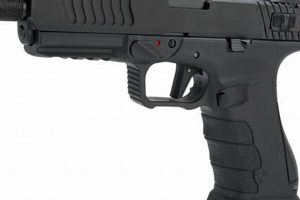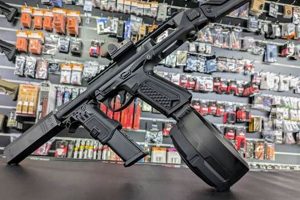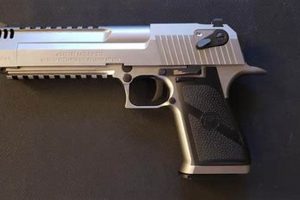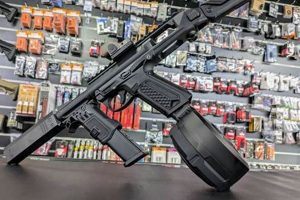The category encompasses manually operated, air-pressured projectile devices that utilize a coiled spring to generate the force needed to propel a plastic pellet. These devices represent an entry-level option within the broader market, often chosen for their simplicity and affordability. A representative example would be a sidearm replica requiring the user to manually cock the slide before each shot.
These devices offer several advantages, including minimal maintenance requirements, independence from external power sources such as batteries or compressed gas, and lower initial investment costs. Historically, these devices have served as introductory tools for individuals new to the sport, allowing them to familiarize themselves with basic handling and safety procedures without significant financial commitment. Their simplicity also contributes to enhanced reliability and ease of repair.
The subsequent discussion will address key considerations for selecting a suitable model, focusing on factors such as build quality, accuracy, durability, and typical applications. Furthermore, common upgrades and modifications that can enhance performance will be explored, along with a comparative analysis of available options across different price points.
Selection and Maintenance Considerations
The following guidelines provide insights into choosing and maintaining manually operated, spring-powered projectile devices to optimize performance and longevity.
Tip 1: Prioritize Build Material: Examine the construction material of the device. Models constructed with durable polymers or metal alloys generally exhibit greater resistance to wear and tear, contributing to increased lifespan.
Tip 2: Assess Internal Components: Investigate the quality of internal components, particularly the spring and piston. Upgraded or reinforced components can enhance power and improve consistency in operation.
Tip 3: Evaluate Accuracy Potential: Consider the inherent accuracy of the device. While precision may be limited compared to higher-end models, certain designs incorporate adjustable hop-up systems to improve projectile trajectory and range.
Tip 4: Implement Regular Cleaning: Adhere to a consistent cleaning schedule. Debris and lubricant buildup can negatively impact performance. Use appropriate cleaning solutions and follow manufacturer guidelines.
Tip 5: Perform Spring Maintenance: Periodically inspect the spring for signs of wear or deformation. Replacing a worn spring can restore original power and prevent mechanical failure.
Tip 6: Lubricate Moving Parts: Apply silicone-based lubricant to moving parts, such as the slide and trigger mechanism. This reduces friction and ensures smooth operation.
Tip 7: Storage Considerations: When not in use, store the device in a cool, dry environment away from direct sunlight. This prevents damage to plastic components and corrosion of metal parts.
Adhering to these guidelines will contribute to informed decision-making and sustained performance, ensuring optimal utility and extending the operational lifespan of the selected device.
The subsequent section will summarize the primary advantages and disadvantages associated with the technology.
1. Reliability
Reliability, in the context of manually-operated, spring-powered projectile devices, denotes the consistency and dependability of the mechanism’s operation under normal usage conditions. It directly impacts the user’s ability to consistently engage targets and maintain effective participation in airsoft activities.
- Mechanical Consistency
Mechanical consistency refers to the uniformity of performance across successive uses. A device exhibiting high mechanical consistency will consistently propel projectiles at similar velocities and trajectories, minimizing variations due to internal component inconsistencies or malfunctions. For example, a model with a well-calibrated spring and a precisely manufactured piston will demonstrate greater consistency compared to one with poorly matched components. Implication, consistency of shots during airsoft gameplay.
- Material Durability and Longevity
Material durability directly influences the operational lifespan of the device. Components constructed from robust materials, such as reinforced polymers or metal alloys, are less susceptible to wear and tear, extending the period of reliable operation. A model incorporating a metal slide and a reinforced spring guide will generally exhibit greater longevity compared to a model built entirely from low-grade plastic. Implication, longer lasting and better investment.
- Resistance to Environmental Factors
Reliability is also influenced by the device’s resistance to environmental factors, such as temperature fluctuations, moisture, and dust. A device designed with sealed internal components and corrosion-resistant materials will maintain functionality in a wider range of operating conditions. For example, a model with a weatherproofed spring housing and a sealed piston chamber will be less susceptible to performance degradation due to environmental exposure. Implication, perform well during outdoors games.
In summary, reliability is a multifaceted attribute encompassing mechanical consistency, material durability, and environmental resistance. A manually-operated, spring-powered projectile device excelling in these areas provides a dependable and consistent user experience, enhancing its overall value proposition. The integration of quality materials, precise engineering, and robust construction contributes significantly to the device’s long-term reliability, making it a preferred choice for those seeking a consistent and dependable device.
2. Affordability
Affordability serves as a pivotal determinant in the selection of manually-operated, spring-powered projectile devices. The inherent cost-effectiveness of these devices stems from their simplified mechanical design, which necessitates fewer complex components and manufacturing processes. This reduced complexity directly translates to lower production costs, thereby enabling manufacturers to offer these devices at significantly lower price points compared to their electrically-powered or gas-powered counterparts. For instance, a spring-powered sidearm replica may be available for under $30, whereas a comparable electrically-powered model could easily exceed $100.
The accessibility afforded by this lower price point expands the potential user base, making the sport more inclusive for individuals with budgetary constraints or those new to the activity who wish to minimize their initial investment. The affordability factor also enables users to acquire multiple devices for different roles or scenarios without incurring substantial financial strain. A practical application of this advantage is the ability to own several spring-powered sidearms for training purposes or as backup options during more intensive scenarios. Furthermore, this lower cost often reduces the barrier to entry for younger participants or individuals exploring airsoft as a recreational activity.
In conclusion, affordability is not merely a superficial attribute but a fundamental characteristic that significantly impacts accessibility, promotes inclusivity, and facilitates broader participation in the airsoft community. While higher-end models may offer enhanced performance, the cost-effectiveness of spring-powered variants provides a viable and often preferred option for individuals seeking an affordable entry point into the sport. It is crucial that consumers balance affordability with other factors such as build quality and long-term durability, but the cost advantage remains a primary driver in the purchase decision for many users.
3. Simplicity
Simplicity, in the context of manually-operated, spring-powered projectile devices, refers to the uncomplicated design and operational mechanisms that characterize these models. This inherent simplicity contributes significantly to their appeal, functionality, and overall user experience.
- Minimal Component Count
These devices typically comprise a relatively small number of parts compared to their gas-powered or electrically-powered counterparts. The reduced complexity minimizes potential points of failure, enhancing reliability and simplifying maintenance procedures. For example, the absence of intricate gas valves or electronic circuitry found in other models translates to a lower probability of mechanical or electrical malfunctions. Implication, less prone to breakdowns, simplified repairs.
- Straightforward Operation
Operation generally involves manually cocking the spring mechanism and then pulling the trigger to release the compressed energy, propelling the projectile. This direct, mechanical action eliminates the need for external power sources, such as batteries or compressed gas, streamlining the user experience and removing dependencies on additional equipment. An example is the simple slide-cocking action required before each shot, a process easily mastered by novice users. Implication, easy learning curve, no need for batteries or gas.
- Reduced Maintenance Requirements
The simplified design translates to lower maintenance demands. The absence of complex internal components that require frequent cleaning or lubrication reduces the overall upkeep burden. For instance, there are no intricate gas lines to clean or batteries to replace, resulting in a device that demands less attention and specialized maintenance. Implication, fewer maintenance procedures, lower long-term running costs.
- Ease of Disassembly and Repair
The uncomplicated construction facilitates disassembly and repair processes. The relatively few parts are easily accessible, enabling users to perform basic maintenance tasks or component replacements with minimal technical expertise. An example would be the ease with which the spring or piston can be replaced using basic tools, reducing the need for professional repair services. Implication, user-friendly repairs, reduced reliance on external service providers.
In summary, the simplicity inherent in manually-operated, spring-powered projectile devices offers several advantages, including enhanced reliability, ease of operation, reduced maintenance requirements, and simplified repair procedures. These benefits contribute to a user-friendly experience, making these devices an attractive option for both novice and experienced users alike. The combination of straightforward design and robust functionality enhances their overall value proposition in the market.
4. Durability
Durability, in the context of manually-operated, spring-powered projectile devices, represents a crucial attribute that determines the device’s ability to withstand prolonged use, resist damage from external factors, and maintain operational effectiveness over an extended period. The inherent ruggedness of a device directly impacts its lifespan and long-term value proposition.
- Material Strength and Resilience
The composition of the device’s components significantly influences its ability to withstand stress and physical impacts. Devices constructed from high-quality polymers or metal alloys generally exhibit greater resistance to cracking, bending, or breaking under pressure. For instance, a model featuring a reinforced polymer frame and a metal slide will inherently possess greater durability compared to a model constructed entirely from lower-grade plastics. Implication, withstanding drops and impacts during gameplay and transport.
- Resistance to Wear and Tear
The ability to withstand the cumulative effects of repeated use is paramount. Components subjected to friction or stress, such as the spring, piston, and trigger mechanism, must be constructed from materials capable of resisting wear, deformation, and fatigue. A model employing a high-tensile steel spring and a self-lubricating piston will likely demonstrate greater longevity and maintain consistent performance over a longer period. Implication, maintaining performance standards even after extended use.
- Environmental Hardiness
Exposure to environmental factors, such as temperature fluctuations, humidity, and dust, can negatively impact the structural integrity and functionality of the device. Components should be resistant to corrosion, warping, or degradation caused by these elements. A model featuring a corrosion-resistant coating on metal parts and a sealed internal mechanism will be better equipped to withstand adverse environmental conditions. Implication, reliable operation across different weather conditions and environments.
- Construction Quality and Assembly
The manner in which the device is constructed and assembled plays a significant role in its overall durability. A well-designed and precisely assembled device will exhibit greater structural integrity and resistance to component separation or misalignment. A model featuring tight tolerances, robust fasteners, and reinforced stress points will generally prove more durable than a model with loose connections or poorly fitted parts. Implication, a longer lasting product that won’t fall apart easily.
In summary, durability is a multifaceted characteristic encompassing material strength, resistance to wear, environmental hardiness, and construction quality. The integration of these elements into the design and manufacturing process directly influences the device’s long-term performance and reliability. Devices demonstrating exceptional durability offer enhanced value by minimizing the need for frequent repairs or replacements, ultimately providing a more cost-effective and satisfying user experience.
5. Accuracy
Accuracy represents a key performance metric for manually-operated, spring-powered projectile devices, influencing the user’s ability to effectively engage targets and achieve desired outcomes. While these devices may not match the precision of higher-end counterparts, several factors contribute to maximizing their potential for accurate projectile placement.
- Hop-Up System Effectiveness
The hop-up system, when present, imparts backspin to the projectile, counteracting gravity and extending its range. The effectiveness of this system directly impacts accuracy by stabilizing the projectile’s trajectory. Models with adjustable hop-up mechanisms allow users to fine-tune the backspin to match the projectile weight and range requirements. Improper hop-up settings can lead to erratic projectile flight paths and reduced accuracy. An example would be adjusting the hop-up unit until the projectile travels in a straight line at a specified distance, or compensating for BB weight. The implication is enhanced hit probability at varying distances.
- Barrel Quality and Consistency
The quality and internal diameter consistency of the barrel significantly influence projectile flight. A smooth, precisely bored barrel reduces friction and minimizes deviations in the projectile’s path. Variations in barrel diameter can lead to inconsistent projectile velocities and unpredictable trajectories. Models with tighter bore barrels typically exhibit enhanced accuracy compared to those with wider or inconsistent bores. A practical example would be comparing the groupings when fired from a tight bore versus a stock bore barrel, and its effect to gameplay is increased precision.
- Trigger Mechanism Consistency
The consistency of the trigger mechanism impacts the shooter’s ability to maintain a stable aiming point during the firing process. A smooth, predictable trigger pull minimizes movement and reduces the likelihood of disturbing the device’s alignment. Jerky or inconsistent trigger pulls can introduce errors that negatively impact accuracy. A modified trigger mechanism will usually decrease the force required to trigger the shot. The implication is maintaining a stable firing position.
- Projectile Quality and Uniformity
The quality and uniformity of the projectiles used also contribute to overall accuracy. Projectiles with consistent weight, shape, and surface finish will exhibit more predictable flight characteristics. Variations in projectile quality can lead to erratic trajectories and reduced accuracy. High-quality, precisely manufactured projectiles minimize these variations. The implication is increased consistency, and improved targeting. Use high quality BBs will often result in more accurate shots during gameplay.
In conclusion, achieving optimal accuracy with manually-operated, spring-powered projectile devices necessitates attention to several key factors, including the effectiveness of the hop-up system, the quality and consistency of the barrel, the smoothness of the trigger mechanism, and the quality of the projectiles used. By carefully considering these elements, users can maximize the accuracy potential of their devices and enhance their overall performance.
Frequently Asked Questions
This section addresses common inquiries concerning manually operated, spring-powered projectile devices, providing comprehensive information to assist in informed decision-making.
Question 1: What distinguishes manually operated, spring-powered projectile devices from gas-powered or electrically-powered models?
Spring-powered devices utilize a manually compressed spring to propel projectiles, while gas-powered models employ compressed gas, and electrically-powered models use batteries to power an internal mechanism. Spring-powered devices are generally simpler, more affordable, and require less maintenance.
Question 2: What is the typical effective range of manually operated, spring-powered projectile devices?
The effective range generally falls between 50 to 100 feet, contingent upon the specific model, projectile weight, and environmental conditions. Upgrades to the hop-up system can potentially extend the range.
Question 3: What type of maintenance is required for manually operated, spring-powered projectile devices?
Maintenance primarily involves cleaning the barrel and lubricating moving parts with silicone-based lubricants. Periodic inspection of the spring and piston for wear is also recommended.
Question 4: What projectile weight is optimal for use with manually operated, spring-powered projectile devices?
The optimal projectile weight typically ranges from 0.12g to 0.20g. Lighter projectiles generally achieve higher velocities, while heavier projectiles offer improved stability and accuracy, especially at longer ranges.
Question 5: Are there any safety precautions to observe when using manually operated, spring-powered projectile devices?
Eye protection is mandatory at all times. It is imperative to avoid aiming at individuals’ faces or unprotected areas. Responsible handling and adherence to established safety guidelines are essential.
Question 6: Can manually operated, spring-powered projectile devices be upgraded to enhance performance?
Yes, common upgrades include replacing the spring, piston, and barrel. These modifications can improve power, accuracy, and overall performance, but require caution to ensure compatibility and safety.
In summary, spring-powered devices offer a simple, affordable, and reliable entry point into the sport, requiring basic maintenance and adherence to safety protocols. While upgrades are possible, careful consideration of compatibility and safety is paramount.
The subsequent section will examine specific models within the category.
Conclusion
The preceding analysis has explored various facets of the manually-operated, spring-powered projectile device category. Emphasis has been placed on key selection criteria, including reliability, affordability, simplicity, durability, and accuracy. Furthermore, common maintenance procedures, safety considerations, and upgrade possibilities have been examined to provide a comprehensive overview.
Ultimately, the selection of a “best spring powered airsoft pistol” depends on individual needs and priorities. By carefully weighing the aforementioned factors and adhering to established safety guidelines, users can make informed decisions that align with their specific requirements and enhance their overall experience. Continued advancements in materials and design may further refine the performance and reliability of these devices, solidifying their place within the broader recreational market.







